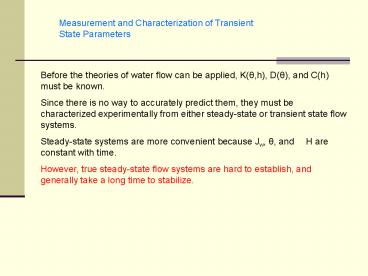Measurement and Characterization of Transient State Parameters - PowerPoint PPT Presentation
1 / 11
Title:
Measurement and Characterization of Transient State Parameters
Description:
... or Tension Permeameter. Water in the permeameter is adjusted ... When placed in contact with the soil, the greater tension draws moisture from the permeameter ... – PowerPoint PPT presentation
Number of Views:76
Avg rating:3.0/5.0
Title: Measurement and Characterization of Transient State Parameters
1
Measurement and Characterization of Transient
State Parameters
Before the theories of water flow can be applied,
K(?,h), D(?), and C(h) must be known. Since there
is no way to accurately predict them, they must
be characterized experimentally from either
steady-state or transient state flow
systems. Steady-state systems are more convenient
because Jw, ?, and ?H are constant with
time. However, true steady-state flow systems are
hard to establish, and generally take a long time
to stabilize.
2
Laboratory Techniques
- In general, K(?) is measured by applying a
constant gradient and measuring the steatdy-state
discharge flux from a sample sandwiched between
two porous plates. - Samples can be de-saturated by either tension or
pressure plate apparatus. - Measurements are made at successive matric
potentials and ? hence K(h), K(?), D(?) and C(h)
may be determined.
?P
3
- Another widely used transient flow method is
called the outflow method wherein the falling
rate of outflow from a sample in a pressure cell
is measured as P is incrementally increased.
P
However, there are often difficulties from the
hydraulic resistance of the porous plate, and the
soil/plate contact.
4
An alternative steady-state technique is to
induce evaporation from long, identically
packed soil columns. If the columns are long
enough, a series of tensiometers can be used to
measure h and ? can be determined by subsequent
sectioning or gamma ray attenuation.
Ep
h1
K(?), D(?), and C(h) can thus be determined over
a wide range of ?.
h2
h3
h4
5
Field Measurement
Sprinkler Infiltration Application at a rate R
where RltKe eventually results in a steady-state
moisture distribution in the conducting
profile. Since as time goes to infinity ?H
1, the flux (or rate of application) is equal to
K(?) How do we know ?H 1? From Jw - K(?)?H
- K(?) (?h/?z 1) As t 8, the soil gets
closer to constant ? and ?h/?z 0
6
R Jw K(?)
K(?), ?, D(?), and C(h)
As long as R remains less than Ks, variable
application rates result in variable K(?), ?,
D(?), and C(h)
7
Infiltration through an impeding layer.
Requires a series of runs.
The h of the subsoil increases with increasing
hydraulic resistance of the crust.
K(?), ?, D(?), and C(h) are reduced in the
infiltrating profile
The effect of an impeding layer is to decrease
the hydraulic potential (i.e., becomes more
negative) in the profile beneath the layer (see
earlier example on flux through a layered system).
8
Disc or Tension Permeameter
Water in the permeameter is adjusted to a tension
of - 1 to - 2 cm
K(?), D(?), Jw(?), C(h)
When placed in contact with the soil, the greater
tension draws moisture from the permeameter
9
Internal Drainage (Redistribution)
Start with and initially saturated condition
Frequent and simultaneous measurement of ? and h
under drainage by gravity allow the determination
of Jw(?), K(?), D(?)
10
(No Transcript)
11
(No Transcript)































